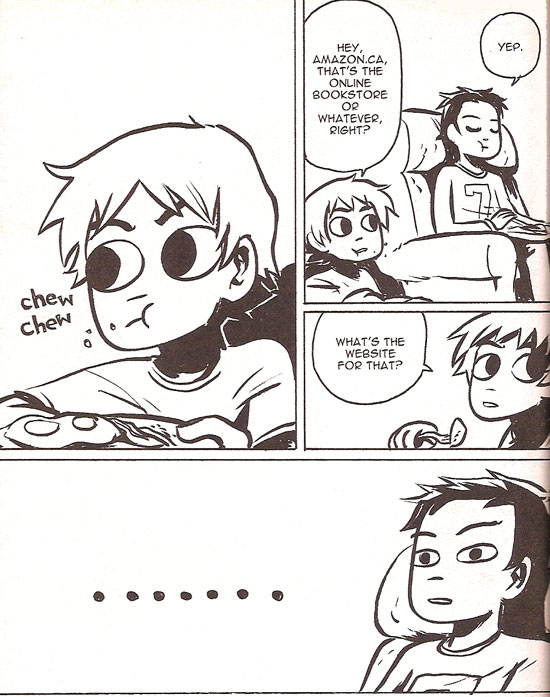Read This: Scott Pilgrim Vs. the World

Scott Pilgrim Vs. the World is the second volume of Bryan Lee O’Malley’s six-book series, and after the first volume started as romantic comedy then veered into megapop urban fantasy, it was worth asking: Could the story sustain that massive tectonic shift? Luckily, the answer was yes.
This installment actually starts out with a lengthy flashback which establishes some key relationship dynamics in the series while reinforcing the videogame elements of their world: Scott Pilgrim’s been defeating the bosses and rescuing the girl ever since school, and it’s just another part of life, not terribly remarkable in and of itself. When the story returns to the present, his developing romance with Ramona Flowers is shaped not only by the whole “defeat her seven evil exes” thing, but by his ex-girlfriend’s rapid transformation from slagging Ramona for being “old” and “fat” to launching a ninja attack at a public library—but still remaining true to her fundamental characterization as a jealous teenager. Meanwhile, there’s still plenty of “ordinary” scenes, although some of these are played for laughs, like the scene where Scott brings Ramona over to meet his bandmates, who share a recipe for vegetarian shepherd’s pie with the readers.
In fact, this volume is much more about character development than it is about the fight scenes: Scott can barely work up interest in training to defeat the latest ex, and he’s the first to admit that their fight is underwhelming. Meanwhile, the web of connections between the various characters grows tighter, and one of the major plotlines hinted at throughout the first volume—the mysterious girlfriend who broke up with Scott long before the story officially began—comes through in a way that perfectly sets things up for a massive blowout in the next installment.
13 August 2010 | read this |
Read This: Scott Pilgrim’s Precious Little Life
For various reasons, it looks like I’m not going to be able to see the Scott Pilgrim Vs. the World movie until after its opening weekend, but that’s okay because it’s giving me some time to re-read the original graphic novels (and to read the sixth and final volume for the first time).

It’s easy to forget, after having the scenes from the movie trailer drilled into my forememory for several months, just how mundane this story can be—by which I don’t mean that it’s boring, just that it’s not all videogame fight fantasies. The opening chapters of Scott Pilgrim’s Precious Little Life are primarily about 23-year-old Scott’s half-hearted relationship with a high school senior, which hardly anybody thinks is a good idea, and his initial encounter with Ramona Flowers. Things start to get a little urban fantasy when Ramona explains that she’s been showing up in Scott’s dreams before he actually met her because there’s a “subspace highway” that goes right through his head, but that’s still just a blip of weirdness in an otherwise normal romantic comedy (complete, as the excerpt above demonstrates, with perpetually put-upon gay best friend). It’s not until Matthew, the first of Ramona’s evil ex-boyfriends, attacks Scott at his band’s concert that the weirdness kicks into high gear—and one of my favorite things about the book is how Bryan Lee O’Malley’s artwork rises to the occasion, bursting into consecutive double-page spreads and layouts influenced by manga fight scenes, but still retaining the rough, deceptively sketchy quality of his lines. In a recent interview, O’Malley discussed his early manga and video game influences and how they were shaped by later reading:
“Obviously, I played a lot of video games when I was a kid, through middle school and high school. I was really into manga too… [But] it wasn’t like I had read a whole lot of shonen manga before then. (Even a Monkey Can Draw Manga) described the structure of shonen manga plots kind of like it’s a shish-kebab, where there’s meatball, meatball, meatball on a stick, with each meatball representing a fight; that’s how it explained what shonen manga really is. So that just kind of stuck in my head… Also, I wanted to do a comic with fights in it, because I feel that comics are good at that, or that comics are supposed to be about fights.”
Note: Shonen is a specific sub-genre of manga aimed at an audience of boys aged 10-18, and in retrospect it’s actually sort of interesting how you can read Precious Little Life in the spirit of a YA novel, as a sort of teenage fantasy version of what life’s going to be like when you’re in your twenties that, about halfway through, kicks into this even trippier fantasy where video game moves are a perfectly natural part of your daily life, such that somebody can point out that Scott is “the best fighter in the province” and nobody thinks that’s at all an unusual statement. It’s a bold shift to make in only the first volume of a six-book series—the question is, will that shift work as the story continues?
11 August 2010 | read this |

 Our Endless and Proper Work is my new book with Belt Publishing about starting (and sticking to) a productive writing practice.
Our Endless and Proper Work is my new book with Belt Publishing about starting (and sticking to) a productive writing practice. 
